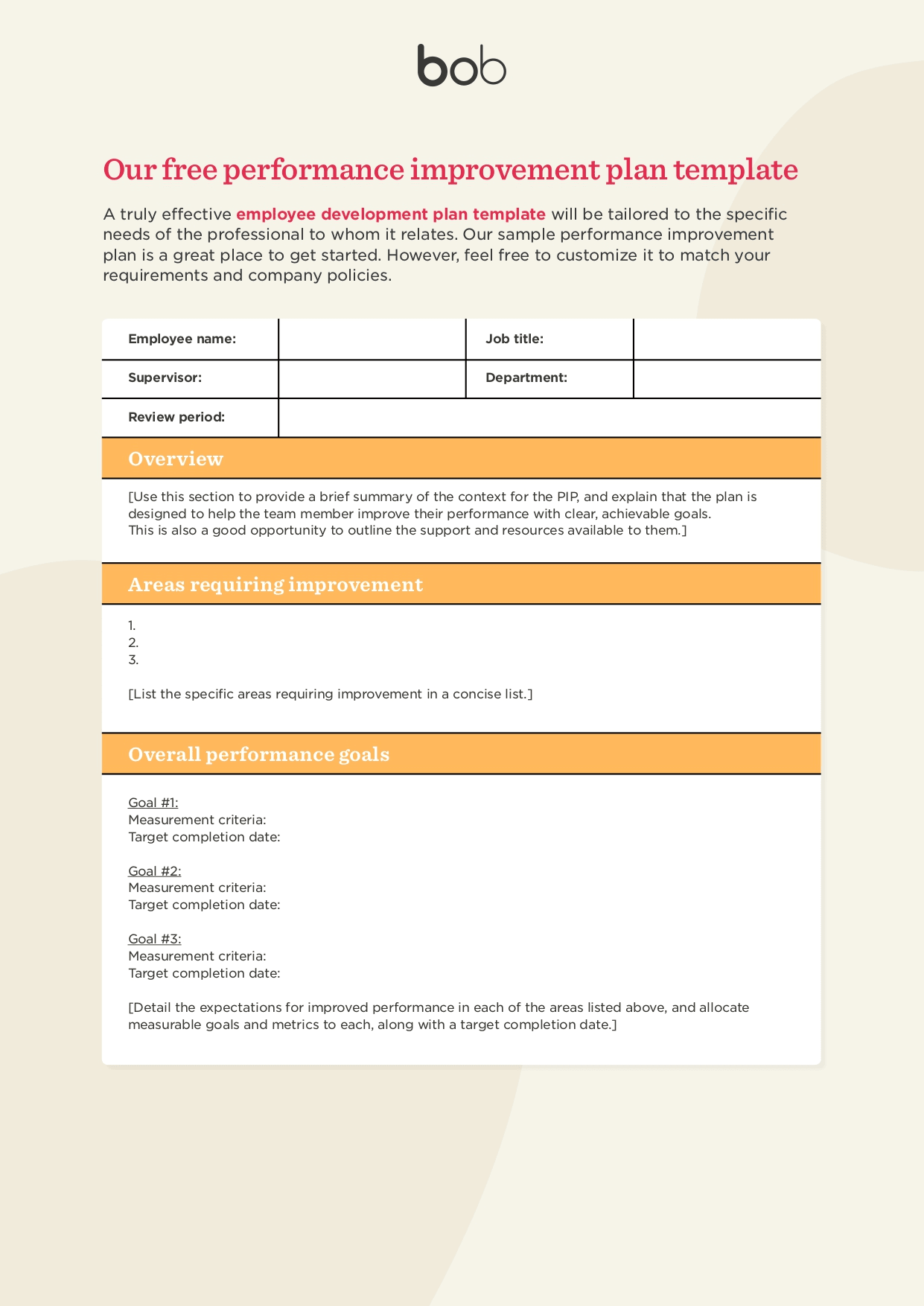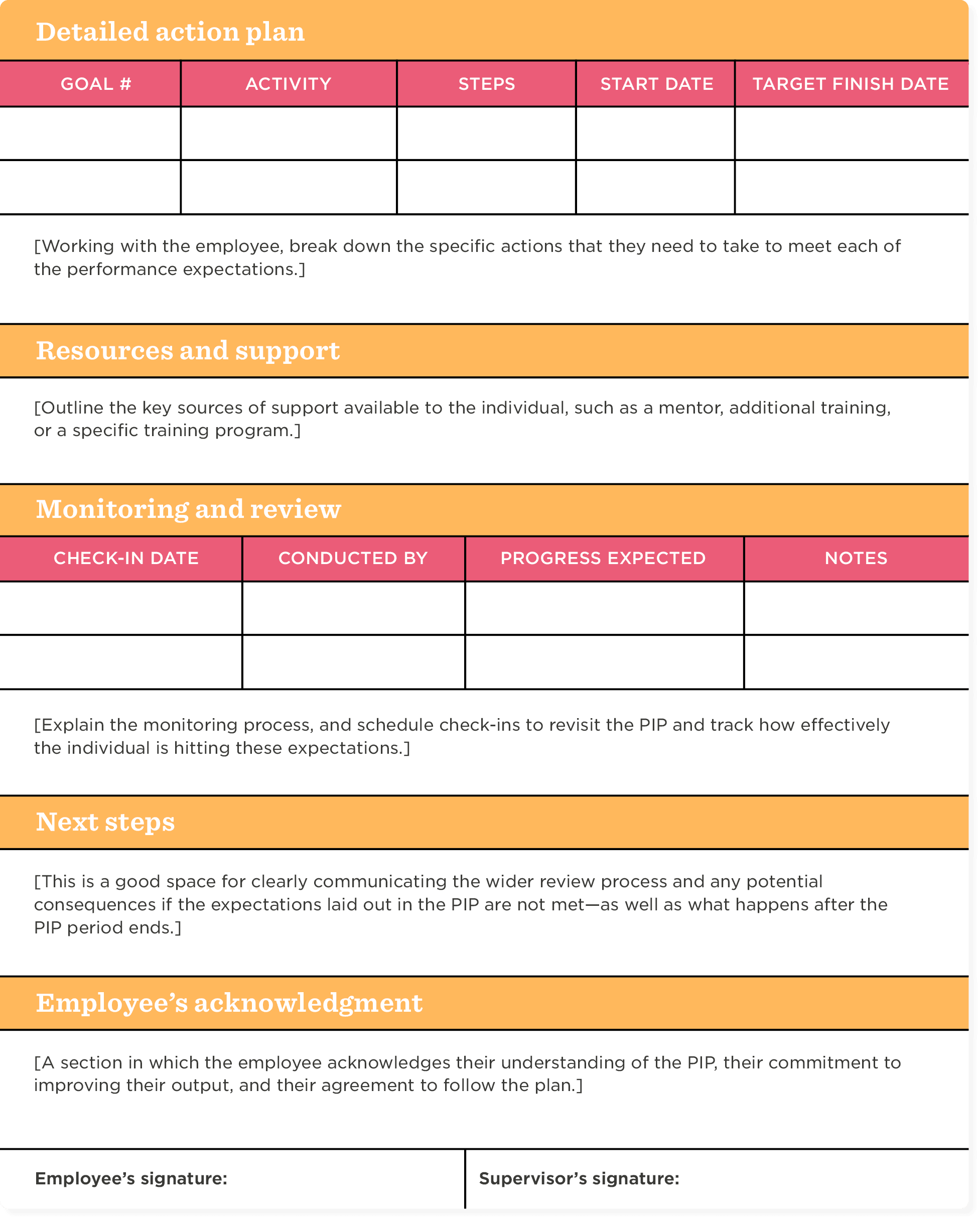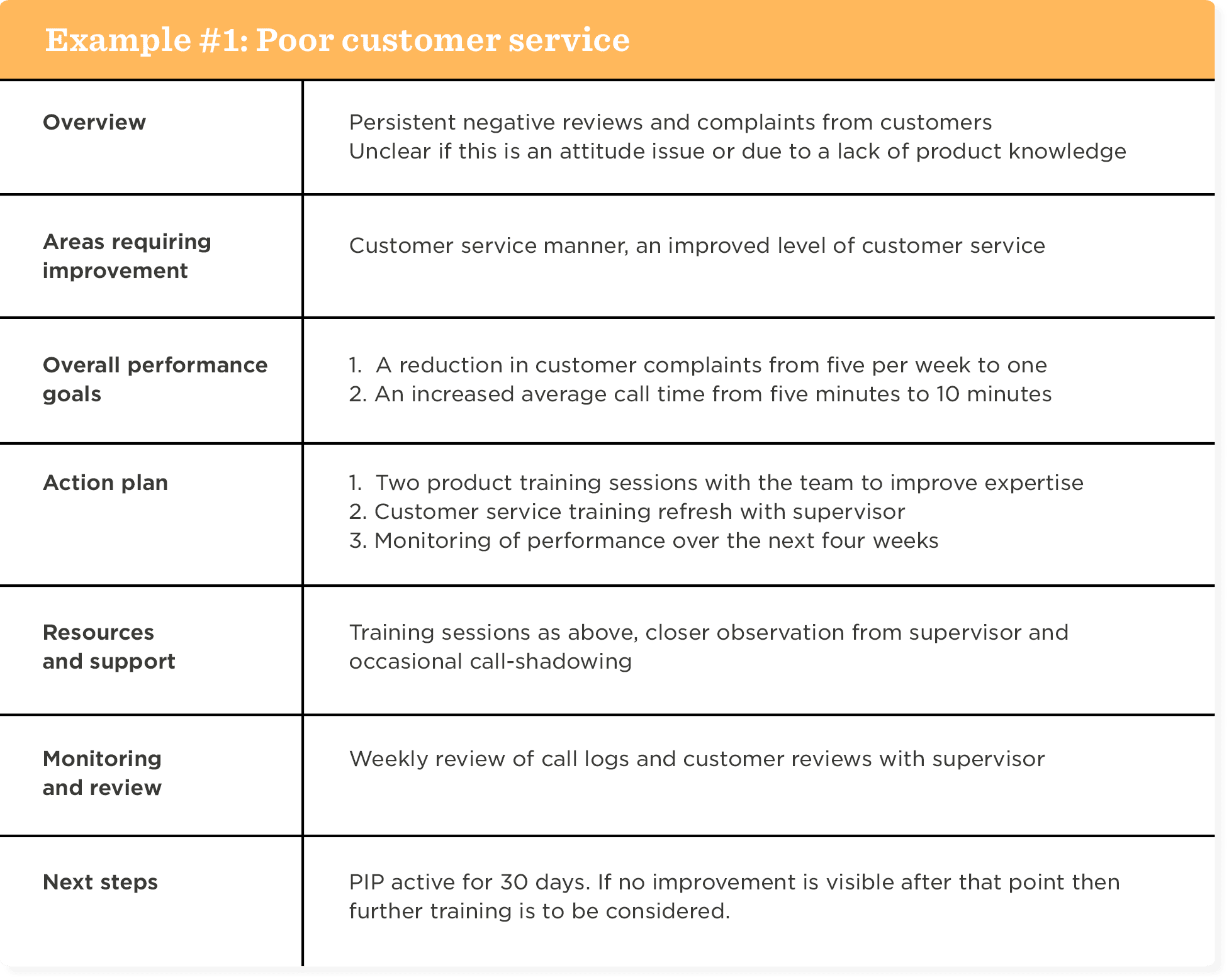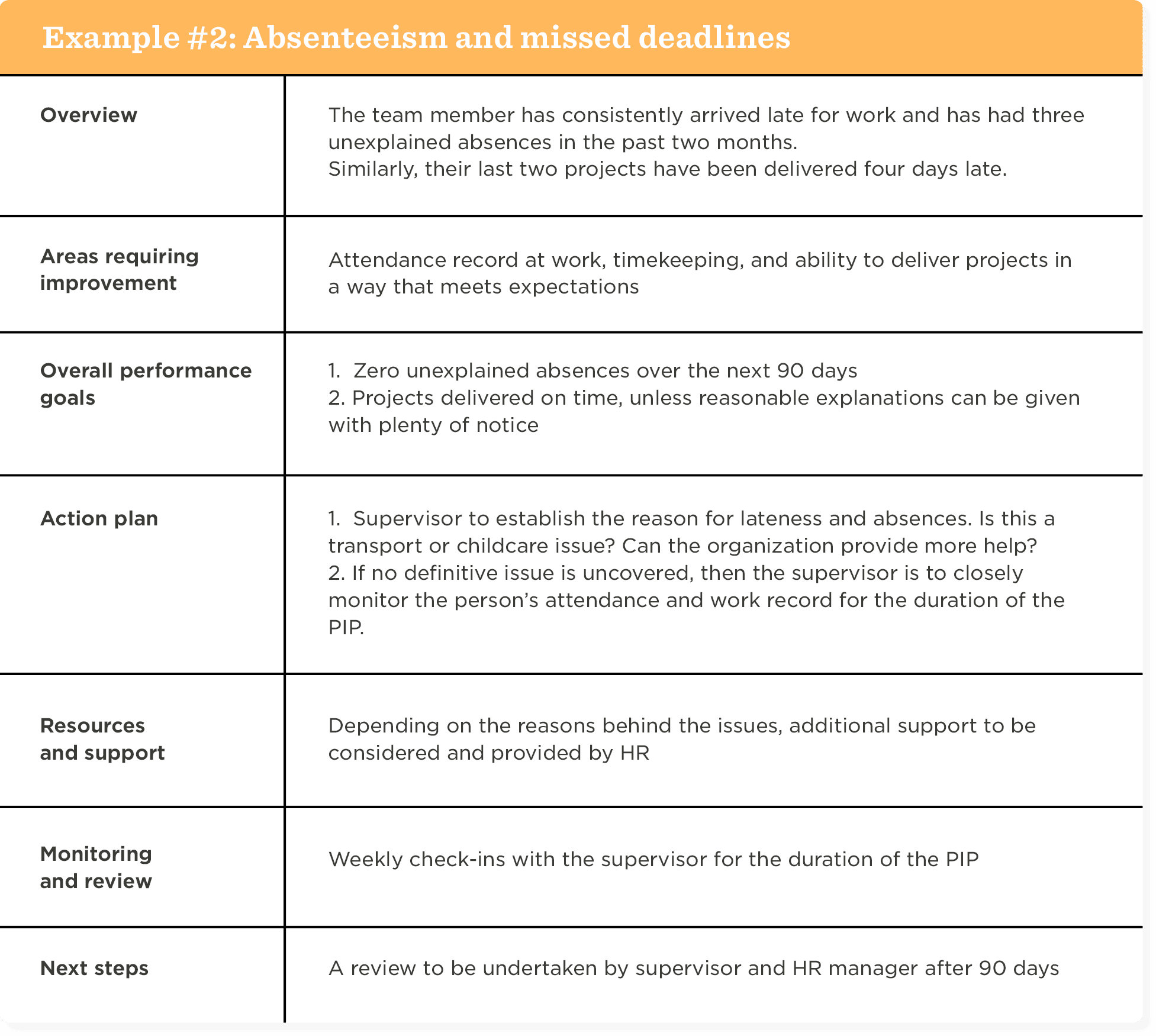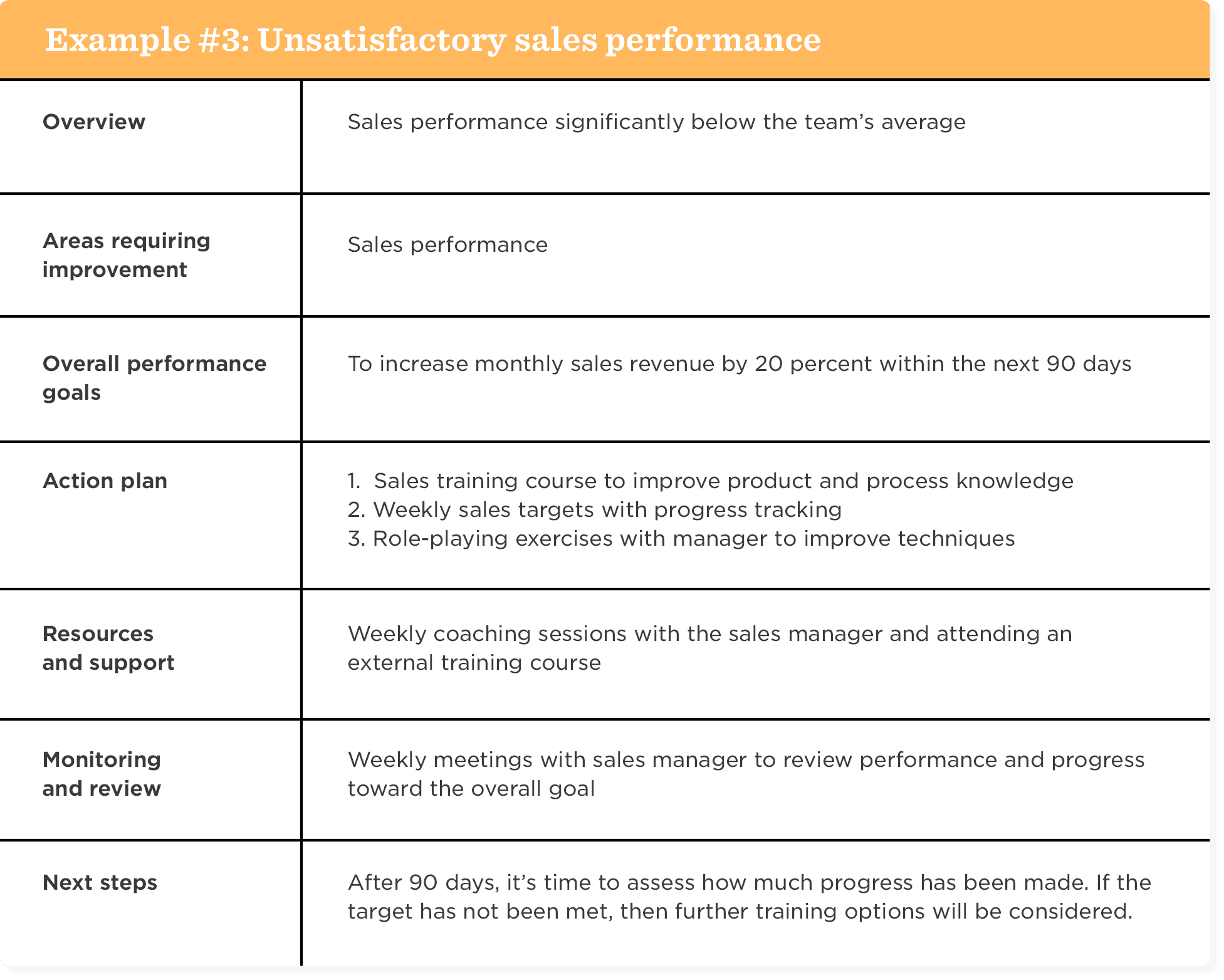When someone on your team is experiencing a skills gap, it’s your job to help them get back on track. That means defining the skills that need refining and laying out actionable, measurable goals for improvement. Doing so shows your people that you value them, believe in their potential, and fully support their professional growth.
This is where a performance improvement plan template (PIP) comes in. It’s a structured document that outlines the specific areas of improvement you’d like an individual to focus on and offers a roadmap to help them take their skill set to the next level. A PIP helps both employers and professionals move forward by detailing an organized approach to performance management, free from ambiguity.
This guide looks at how to write a comprehensive PIP and shares a downloadable employee performance improvement plan template for you to customize.
<<Download our free, performance improvement plan template.>>
What is a performance improvement plan?
A performance improvement plan is an official document that outlines specific skills a team member needs to improve and maps out how they can reach their full potential. PIPs empower struggling team members to overcome professional roadblocks using clear and supportive guidance.
An effective PIP will identify problems, set expectations, and chart actionable steps the person can take to close performance gaps. The plan may also outline the consequences if they don’t meet the objectives, helping to align the individual’s goals with the wider team’s objectives and giving them a sense of purpose and direction.
A PIP encourages open communication and collaboration as you work through any issues together. It provides a clear measurement of the improved performance you wish to see, giving everyone a better chance of achieving that outcome.
Why use a performance improvement plan template?
Creating your own performance improvement plan from scratch can be a time-consuming task. A template can save you time and help you treat PIPs equitably across your organization.
Using a PIP template helps to improve your:
- Consistency. A template ensures your teams will follow a structured and consistent format for creating PIPs throughout the organization. This ensures your team treats everyone fairly and doesn’t overlook any important elements.
- Efficiency. Using a template saves your team time and effort, especially when dealing with multiple team members or creating PIPs regularly. It provides a starting point, reducing the need to build a plan from nothing each time.
- Clarity. Our PIP template provides clear sections for identifying performance issues, setting expectations, outlining action plans, and specifying consequences. This makes it easy for everyone to understand and follow the plan.
- Customization. The basic structure provided by a performance improvement plan sample allows team members to customize it to suit the specific needs of each person and situation.
- Professionalism. Establishing an organization-wide template allows you to unify the design and format of each PIP, making them feel more professional and supporting a more coherent approach to performance improvement.
- Documentation. Any HR process around a performance issue requires comprehensive documentation for legal compliance purposes. A PIP template encourages your people to keep a record of issues, expectations, steps, and outcomes, and can be a valuable progress-tracking and reference resource for future evaluations or reviews.
- Training. Templates can be used as training tools for HR personnel and managers, helping them understand the key components of a PIP, any specific details unique to yours, and how they can create one when needed.
- Accountability. A PIP template makes everyone involved in the performance review process accountable, with signatures and notes to reflect everyone’s agreement to follow the process laid out.
<<Download our free, performance improvement plan template>>
Free performance improvement plan sample template
A truly effective employee development plan template will be tailored to the specific needs of the professional to whom it relates. Use our sample performance improvement plan as a jumping off point and customize it to match your requirements and company policies.
<<Download our free, printable PIP template>>
When to use a performance improvement plan
PIPs are better suited to certain situations over others. A few common scenarios when a PIP can be helpful include:
- Lacking job performance. When someone is struggling to meet expectations or maintain consistent performance, a PIP can provide clarity on what specific skills and deliverables need improvement and how to make it happen.
- Missed deadlines. Persistent delays in meeting deadlines can disrupt workflows. A PIP can set clear timelines and offer tools to improve time management.
- Unprofessional behavior. In situations where a colleague exhibits unprofessional conduct, such as poor communication or inappropriate workplace interactions, a PIP can guide them toward positive change by outlining acceptable behaviors.
- Behavior affecting team morale. If one person’s performance or behavior impacts the overall morale or productivity of the team, a PIP can help realign their efforts and build a stronger team dynamic.
When not to use a performance improvement plan
PIPs are a great way to address some challenges—but not all. It’s important to recognize when other approaches might be more effective. Here are a few situations where a PIP isn’t the right fit:
- Personal issues. If someone’s performance is affected by personal challenges, like health concerns or family matters, a PIP won’t necessarily address the root cause of the issue. Instead, offering support, flexible work schedules, or accommodations can be more effective.
- Steps toward termination. A PIP shouldn’t be used as a procedural step toward termination without a real intent to support improvement. Its purpose is to guide and develop, not to be used as a checkbox before parting ways.
- Negligent behavior. For severe issues, such as misconduct, negligence, or violations of company policies, immediate action might be necessary. In cases of disciplinary infractions, written warnings or other measures are usually more appropriate than a PIP.
Key components of a performance improvement plan
The best performance improvement plan templates tell the story of a performance evaluation. Make sure your PIP plan includes the following components.
Improvement areas
Your PIP should clearly specify the areas of the team member’s performance that require improvement, using examples and data where relevant.
Past review data
Past reviews offer historical perspective on performance. Include data from past annual reviews, feedback from one-on-one sessions, and any documented achievements or setbacks.
Clear expectations
Measurable expectations for improvement make the process crystal clear for everyone involved. Make sure your PIP outlines what success looks like in each area requiring improvement.
Action plan
An effective action plan details the steps required for your co-worker to meet the performance expectations and provides a time frame for each step.
Progress monitorization
The impact of a PIP needs to be measured, so it should include notes on how progress will be monitored, including the frequency of evaluations and who will provide feedback. It’s also useful to include a description of the expected next steps, depending on whether the individual meets the PIP’s objectives by the end of its applicable period.
How to create an effective performance improvement plan
A well-crafted performance improvement plan aims to improve someone’s work rather than punish them. This means it’s important to communicate the grounds for instigating the PIP openly and to establish achievable outcomes. Done right, you’re more likely to help people reach their full potential and provide a positive contribution to your organization.
Here are our top tips for crafting an effective performance improvement plan:
- Be specific and measurable. Achievable goals need to be clearly articulated, so make sure to define the performance issues with concrete examples or data, then set SMART goals for resolving them. Avoid vague language, and create guidelines for objective measurements of success.
- Customize the performance improvement plan template. Customization ensures that you address performance issues accurately and set realistic and relevant goals based on the individual. Adapting the PIP template to your people’s specific circumstances and objectives maximizes the likelihood of successful performance improvements and overall growth.
- Set goals collaboratively. You’re more likely to experience a successful outcome from your PIP if you involve the individual in the goal-setting process. Encouraging their input gives them greater ownership over their improvement goals and ensures they understand and agree with established expectations.
- Provide support, guidance, and resources. The best performers are part of a collaborative and supportive team, so offer the necessary resources, training, coaching, and mentoring to help your people achieve the performance expectations. Use the PIP template to outline the support available and how you’ll provide it.
Performance improvement plan examples
PIPs come in many different forms, depending on the nature of your business and the specific circumstances of each case. Here are key excerpts from some of the most common examples of PIPs that HR teams face, such as a performance improvement plan for attendance issues or missed sales targets.
Example #1: Poor customer service
Example #2: Absenteeism and missed deadlines
Example #3: Unsatisfactory sales performance
Advantages and disadvantages of performance improvement plans
Performance improvement plans offer a structured way to address performance concerns, but there are important pros and cons to consider before using them.
Advantages
PIPs can help your people address and tackle on-the-job challenges. Some key advantages of using a PIP include:
- Structured guidance. PIPs provide a clear framework to pinpoint performance gaps and establish precise improvement goals. This clarity benefits both the individual and the team by setting a unified path forward.
- Improved communication. PIPs promote transparency and collaboration, strengthening working relationships and creating a more supportive environment.
- Focused development. PIPs deliver tailored action plans centered on individual needs, including targeted support and resources. Nurturing your team on an individual level can boost engagement and motivation by showing them you’re invested in their growth.
- Official records. PIPs maintain a formal record of performance issues, expectations, and progress. Formal documentation demonstrates your commitment to consistent performance standards across teams and provides your people with a precise map of milestones to help them turn things around.
Disadvantages
While a PIP is a useful tool to drive growth, there are some drawbacks to keep in mind, including:
- Stigmatization. PIPs are sometimes misunderstood as punitive, leading to feelings of embarrassment or alienation. They can also affect morale and potentially hinder improvement if not handled with care.
- Time-consuming. Developing and managing PIPs demands time and effort from both managers and team members. For companies with limited resources or multiple performance issues, this can be challenging.
- Limited effectiveness. In some situations, PIPs might not yield the desired improvements if the root causes of performance issues—like a lack of resources—aren’t addressed simultaneously.
- Potential for misuse. If not implemented with genuine intent to support improvement, PIPs can be misused as a preliminary step toward termination, instilling fear and eroding trust within your team.
Tips for successful PIP implementation
Successfully implementing a performance improvement plan at work requires clear communication throughout. Everyone involved in the process needs to understand their role and responsibilities and the desired outcomes.
It’s also important to regularly use an employee performance review checklist so you can monitor progress, with ongoing feedback and flexibility to make adjustments where necessary. As you run more PIPs, take lessons on board and be ready to modify your template and approach.
With a coherent training plan supporting the PIP, you’re more likely to set your team up for success. With proper resourcing, open communication throughout, and employee performance management software, a successful PIP process is just around the corner.
Key metrics for tracking PIP objectives
Monitoring the effectiveness of your PIPs involves tracking the right metrics. Some key metrics to consider include:
- Goal achievement rate. Calculate the percentage of goals met within the PIP timeline. Doing so highlights progress and your plan’s effectiveness in reaching desired outcomes.
- Time to improvement. Measure how quickly improvements happen after a PIP starts. Faster improvements indicate the plan is working well.
- Feedback frequency. Regular feedback sessions are crucial. They keep communication open and allow for timely adjustments.
- Engagement level. Monitor changes in engagement and motivation. Increased engagement is a positive sign your PIP is having an impact.
- Skills development. Track the development of new skills or competencies to reflect progress and support long-term growth.
- Retention rate. Check if team members remain with the company post-PIP. High retention rates suggest loyalty and satisfaction.
- Performance rating improvement. Compare ratings before and after the PIP. Improvements here confirm the plan’s success in enhancing performance.
Support your people with a performance improvement plan template
Performance improvement plans provide a clear path for people to level up their skill set and thrive. Using a PIP template makes the process of building them out even smoother, but not just any template will do. The right PIP template saves time, maintains consistency and fairness across your team, and keeps everyone on the same page. It also helps you focus on what’s most important—supporting your team in reaching their goals.
Performance improvement plan template FAQs
How long should a performance improvement plan last?
Ideally, a performance improvement plan runs for 30-90 days. This timeframe offers people enough opportunity to demonstrate meaningful progress and gives managers a realistic window to monitor and support the improvement process.
Does PIP always lead to termination?
No, a PIP doesn’t always lead to termination. In fact, its purpose is to help team members meet specific performance standards rather than to initiate termination proceedings. Many successfully complete their PIP and continue to contribute positively to their company.
What needs to be covered in a performance plan?
A performance plan needs to cover the exact areas in need of improvement, a clear picture of what getting back on track looks like, and a detailed action plan to achieve it. Support resources, improvement timelines, and potential consequences if standards aren’t met are also important elements of a comprehensive PIP that supports team members in meeting both personal and institutional goals.
Recommended For Further Reading
Is a PIP considered a warning?
Yes, a PIP is considered a warning. It’s designed to offer a structured plan for addressing performance issues so HR teams can avoid disciplinary action. If the team member doesn’t meet the plan’s requirements, disciplinary action could be the next step. A PIP should specify what disciplinary action may result from not meeting the goals of the plan.
What is the performance improvement plan success rate?
The success rate for performance improvement plans typically ranges from 47-74 percent. PIP outcomes depend on several factors, including the plan’s clarity, the level of support given, and the individual’s dedication to improvement.

